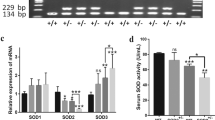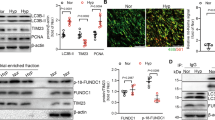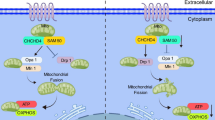Abstract
Obstructive sleep apnea (OSA), characterized by chronic intermittent hypoxia (CIH), is a common risk factor for pulmonary arterial hypertension (PAH). As a hypoxia-induced transcription factor, differentially expressed in chondrocytes (DEC1) negatively regulates the transcription of peroxisome proliferative activated receptor-γ (PPARγ), a recognized protective factor of PAH. However, whether and how DEC1 is associated with PAH pathogenesis remains unclear. In the present study, we found that DEC1 was increased in lungs and pulmonary arterial smooth muscle cells (PASMCs) of rat models of OSA-associated PAH. Oxidative indicators and inflammatory cytokines were also elevated in the blood of the rats. Similarly, hypoxia-treated PASMCs displayed enhanced DEC1 expression and reduced PPARγ expression in vitro. Functionally, DEC1 overexpression exacerbated reactive oxygen species (ROS) production and the expression of pro-inflammatory cytokines (such as TNFα, IL-1β, IL-6, and MCP-1) in PASMCs. Conversely, shRNA knockdown of Dec1 increased PPARγ expression but attenuated hypoxia-induced oxidative stress and inflammatory responses in PASMCs. Additionally, DEC1 overexpression promoted PASMC proliferation, which was drastically attenuated by a PPARγ agonist rosiglitazone. Collectively, these results suggest that hypoxia-induced DEC1 inhibits PPARγ, and that this is a predominant mechanism underpinning oxidative stress and inflammatory responses in PASMCs during PAH. DEC1 could be used as a potential target to treat PAH.








Similar content being viewed by others
Data availability
Additional data that support the findings of this study are available from the corresponding author upon reasonable request.
Abbreviations
- OSA:
-
Obstructive sleep apnea
- CIH:
-
Chronic intermittent hypoxia
- HPH:
-
Hypoxic pulmonary hypertension
- ROS:
-
Reactive oxygen species
- PAECs:
-
Pulmonary arterial endothelial cells
- PASMCs:
-
Pulmonary artery endothelial cells
- PAH:
-
Pulmonary arterial hypertension
- PPARγ:
-
Peroxisome proliferative activated receptor-γ
- DEC1:
-
differentially expressed in chondrocytes
- MDA:
-
Malondialdehyde
- SOD:
-
Superoxide dismutase
- GSH-Px:
-
Glutathione peroxidase
References
Javaheri S, Barbe F, Campos-Rodriguez F, Dempsey JA, Khayat R, Javaheri S, Malhotra A, Martinez-Garcia MA, Mehra R, Pack AI, Polotsky VY, Redline S, Somers VK (2017) Sleep apnea: types, mechanisms, and Clinical Cardiovascular Consequences. J Am Coll Cardiol 69(7):841–858. https://doi.org/10.1016/j.jacc.2016.11.069
Frid MG, McKeon BA, Thurman JM, Maron BA, Li M, Zhang H, Kumar S, Sullivan T, Laskowsky J, Fini MA, Hu S, Tuder RM, Gandjeva A, Wilkins MR, Rhodes CJ, Ghataorhe P, Leopold JA, Wang RS, Holers VM, Stenmark KR (2019) Immunoglobulin-driven complement activation regulates pro-inflammatory remodeling in Pulmonary Hypertension. American journal of respiratory and critical care medicine. https://doi.org/10.1164/rccm.201903-0591OC
Suresh K, Servinsky L, Jiang H, Bigham Z, Zaldumbide J, Huetsch JC, Kliment C, Acoba MG, Kirsch BJ, Claypool SM, Le A, Damarla M, Shimoda LA (2019) Regulation of mitochondrial fragmentation in microvascular endothelial cells isolated from the SU5416/hypoxia model of pulmonary arterial hypertension. Am J Physiol Lung Cell Mol Physiol 317(5):L639–l652. https://doi.org/10.1152/ajplung.00396.2018
Minamino T, Christou H, Hsieh CM, Liu Y, Dhawan V, Abraham NG, Perrella MA, Mitsialis SA, Kourembanas S (2001) Targeted expression of heme oxygenase-1 prevents the pulmonary inflammatory and vascular responses to hypoxia. Proc Natl Acad Sci USA 98(15):8798–8803. https://doi.org/10.1073/pnas.161272598
Green DE, Sutliff RL, Hart CM (2011) Is peroxisome proliferator-activated receptor gamma (PPARgamma) a therapeutic target for the treatment of pulmonary hypertension? Pulmonary circulation 1. 33–47. https://doi.org/10.4103/2045-8932.78101. 1
Ameshima S, Golpon H, Cool CD, Chan D, Vandivier RW, Gardai SJ, Wick M, Nemenoff RA, Geraci MW, Voelkel NF (2003) Peroxisome proliferator-activated receptor gamma (PPARgamma) expression is decreased in pulmonary hypertension and affects endothelial cell growth. Circul Res 92(10):1162–1169. https://doi.org/10.1161/01.res.0000073585.50092.14
Kim EK, Lee JH, Oh YM, Lee YS, Lee SD (2010) Rosiglitazone attenuates hypoxia-induced pulmonary arterial hypertension in rats. Respirol (Carlton Vic) 15(4):659–668. https://doi.org/10.1111/j.1440-1843.2010.01756.x
Hennigs JK, Cao A, Li CG, Shi M, Mienert J, Miyagawa K, Körbelin J, Marciano DP, Chen PI, Roughley M, Elliott MV, Harper RL, Bill MA, Chappell J, Moonen JR, Diebold I, Wang L, Snyder MP, Rabinovitch M (2021) PPARγ-p53-Mediated Vasculoregenerative Program to Reverse Pulmonary Hypertension. Circul Res 128(3):401–418. https://doi.org/10.1161/circresaha.119.316339
Boudjelal M, Taneja R, Matsubara S, Bouillet P, Dolle P, Chambon P (1997) Overexpression of Stra13, a novel retinoic acid-inducible gene of the basic helix-loop-helix family, inhibits mesodermal and promotes neuronal differentiation of P19 cells. Genes Dev 11(16):2052–2065. https://doi.org/10.1101/gad.11.16.2052
Rossner MJ, Dorr J, Gass P, Schwab MH, Nave KA (1997) SHARPs: mammalian enhancer-of-split- and hairy-related proteins coupled to neuronal stimulation. Mol Cell Neurosci 9(5–6):460–475. https://doi.org/10.1006/mcne.1997.0640
Shen M, Kawamoto T, Yan W, Nakamasu K, Tamagami M, Koyano Y, Noshiro M, Kato Y (1997) Molecular characterization of the novel basic helix-loop-helix protein DEC1 expressed in differentiated human embryo chondrocytes. Biochem Biophys Res Commun 236(2):294–298. https://doi.org/10.1006/bbrc.1997.6960
Ivanov SV, Salnikow K, Ivanova AV, Bai L, Lerman MI (2007) Hypoxic repression of STAT1 and its downstream genes by a pVHL/HIF-1 target DEC1/STRA13. Oncogene 26(6):802–812. https://doi.org/10.1038/sj.onc.1209842
Choi SM, Cho HJ, Cho H, Kim KH, Kim JB, Park H (2008) Stra13/DEC1 and DEC2 inhibit sterol regulatory element binding protein-1c in a hypoxia-inducible factor-dependent mechanism. Nucleic Acids Res 36(20):6372–6385. https://doi.org/10.1093/nar/gkn620
Giatromanolaki A, Koukourakis MI, Sivridis E, Turley H, Wykoff CC, Gatter KC, Harris AL (2003) DEC1 (STRA13) protein expression relates to hypoxia- inducible factor 1-alpha and carbonic anhydrase-9 overexpression in non-small cell lung cancer. J Pathol 200(2):222–228. https://doi.org/10.1002/path.1330
Li XM, Lin W, Wang J, Zhang W, Yin AA, Huang Y, Zhang J, Yao L, Bian H, Zhang J, Zhang X (2016) Dec1 expression predicts prognosis and the response to temozolomide chemotherapy in patients with glioma. Mol Med Rep 14(6):5626–5636. https://doi.org/10.3892/mmr.2016.5921
Zheng Y, Shi X, Wang M, Jia Y, Li B, Zhang Y, Liu Q, Wang Y (2012) The increased expression of DEC1 gene is related to HIF-1alpha protein in gastric cancer cell lines. Mol Biol Rep 39(4):4229–4236. https://doi.org/10.1007/s11033-011-1209-0
Chakrabarti J, Turley H, Campo L, Han C, Harris AL, Gatter KC, Fox SB (2004) The transcription factor DEC1 (stra13, SHARP2) is associated with the hypoxic response and high tumour grade in human breast cancers. Br J Cancer 91(5):954–958. https://doi.org/10.1038/sj.bjc.6602059
Ning R, Zhan Y, He S, Hu J, Zhu Z, Hu G, Yan B, Yang J, Liu W (2017) Interleukin-6 induces DEC1, promotes DEC1 Interaction with RXRalpha and suppresses the expression of PXR, CAR and their target genes. Front Pharmacol 8:866. https://doi.org/10.3389/fphar.2017.00866
Le HT, Sato F, Kohsaka A, Bhawal UK, Nakao T, Muragaki Y, Nakata M (2019) Dec1 Deficiency suppresses Cardiac Perivascular Fibrosis Induced by transverse aortic constriction. Int J Mol Sci 20(19). https://doi.org/10.3390/ijms20194967
Olkkonen J, Kouri VP, Hynninen J, Konttinen YT, Mandelin J (2015) Differentially expressed in chondrocytes 2 (DEC2) increases the expression of IL-1beta and is abundantly Present in Synovial membrane in rheumatoid arthritis. PLoS ONE 10(12):e0145279. https://doi.org/10.1371/journal.pone.0145279
Ming X, Bao C, Hong T, Yang Y, Chen X, Jung YS, Qian Y (2018) Clusterin, a Novel DEC1 target, modulates DNA damage-mediated cell death. Mol cancer research: MCR 16(11):1641–1651. https://doi.org/10.1158/1541-7786.mcr-18-0070
Liu Q, Wu Y, Seino H, Haga T, Yoshizawa T, Morohashi S, Kijima H (2018) Correlation between DEC1/DEC2 and epithelialmesenchymal transition in human prostate cancer PC3 cells. Mol Med Rep 18(4):3859–3865. https://doi.org/10.3892/mmr.2018.9367
Liu Q, Imaizumi T, Murakami K, Tanaka H, Wu Y, Yoshizawa T, Morohashi S, Seino H, Kijima H (2017) DEC1 negatively regulates the expression of CXCL10 and CCL5 induced by poly IC in normal human mesangial cells. Biomed Res (Tokyo Japan) 38(4):249–255. https://doi.org/10.2220/biomedres.38.249
Zhu Z, Wang YW, Ge DH, Lu M, Liu W, Xiong J, Hu G, Li XP, Yang J (2017) Downregulation of DEC1 contributes to the neurotoxicity induced by MPP(+) by suppressing PI3K/Akt/GSK3beta pathway. CNS Neurosci Ther 23(9):736–747. https://doi.org/10.1111/cns.12717
Chen SY, Liu ST, Lin WR, Lin CK, Huang SM (2019) The Mechanisms underlying the cytotoxic Effects of Copper Via differentiated embryonic chondrocyte gene 1. Int J Mol Sci 20(20). https://doi.org/10.3390/ijms20205225
Park YK, Park H (2012) Differentiated embryo chondrocyte 1 (DEC1) represses PPARgamma2 gene through interacting with CCAAT/enhancer binding protein beta (C/EBPbeta). Mol Cells 33(6):575–581. https://doi.org/10.1007/s10059-012-0002-9
Zhang Z, Li Z, Wang Y, Wei L, Chen H (2019) Overexpressed long noncoding RNA CPS1-IT alleviates pulmonary arterial hypertension in obstructive sleep apnea by reducing interleukin-1beta expression via HIF1 transcriptional activity. J Cell Physiol 234(11):19715–19727. https://doi.org/10.1002/jcp.28571
Dahal BK, Cornitescu T, Tretyn A, Pullamsetti SS, Kosanovic D, Dumitrascu R, Ghofrani HA, Weissmann N, Voswinckel R, Banat GA, Seeger W, Grimminger F, Schermuly RT (2010) Role of epidermal growth factor inhibition in experimental pulmonary hypertension. Am J Respir Crit Care Med 181(2):158–167. https://doi.org/10.1164/rccm.200811-1682OC
Tan T, Guitart J, Gerami P, Yazdan P (2018) Elastic Staining in differentiating between follicular streamers and follicular scars in horizontal scalp biopsy sections. Am J Dermatopathol 40(4):254–258. https://doi.org/10.1097/dad.0000000000000973
Comhair S, Xu W, Mavrakis L, Aldred MA, Asosingh K, Erzurum SC (2012) Human primary lung endothelial cells in culture. Am J Respir Cell Mol Biol 46(6):723–730
Li X, Liu C, Qi W, Meng Q, Zhao H, Teng Z, Xu R, Wu X, Zhu F, Qin Y, Zhao M, Xu F, Xia M (2021) Endothelial Dec1-PPARγ Axis impairs proliferation and apoptosis homeostasis under Hypoxia in Pulmonary arterial hypertension. Front cell Dev biology 9:757168. https://doi.org/10.3389/fcell.2021.757168
Evans CE, Cober ND, Dai Z, Stewart DJ, Zhao YY (2021) Endothelial cells in the pathogenesis of pulmonary arterial hypertension. Eur Respir J 58(3). https://doi.org/10.1183/13993003.03957-2020
Diebold I, Hennigs JK, Miyagawa K, Li CG, Nickel NP, Kaschwich M, Cao A, Wang L, Reddy S, Chen PI, Nakahira K, Alcazar MA, Hopper RK, Ji L, Feldman BJ, Rabinovitch M (2015) BMPR2 preserves mitochondrial function and DNA during reoxygenation to promote endothelial cell survival and reverse pulmonary hypertension. Cell Metabol 21(4):596–608. https://doi.org/10.1016/j.cmet.2015.03.010
Rubin LJ (1997) Primary pulmonary hypertension. N Engl J Med 336(2):111–117. https://doi.org/10.1056/nejm199701093360207
Luo Y, Teng X, Zhang L, Chen J, Liu Z, Chen X, Zhao S, Yang S, Feng J, Yan X (2019) CD146-HIF-1α hypoxic reprogramming drives vascular remodeling and pulmonary arterial hypertension. Nat Commun 10(1):3551. https://doi.org/10.1038/s41467-019-11500-6
Liu Y, Liu B, Zhang GQ, Zou JF, Zou ML, Cheng ZS (2018) Calpain inhibition attenuates bleomycin-induced pulmonary fibrosis via switching the development of epithelial-mesenchymal transition. Naunyn Schmiedebergs Arch Pharmacol 391(7):695–704. https://doi.org/10.1007/s00210-018-1499-z
Lokmic Z, Musyoka J, Hewitson TD, Darby IA (2012) Hypoxia and hypoxia signaling in tissue repair and fibrosis. Int Rev cell Mol biology 296:139–185. https://doi.org/10.1016/b978-0-12-394307-1.00003-5
Thompson AAR, Lawrie A (2017) Targeting vascular remodeling to treat pulmonary arterial hypertension. Trends in molecular medicine 23. 31–45. https://doi.org/10.1016/j.molmed.2016.11.005. 1
Xiao Y, Chen PP, Zhou RL, Zhang Y, Tian Z, Zhang SY (2020) Pathological mechanisms and potential therapeutic targets of pulmonary arterial hypertension: a review. Aging and disease 11(6):1623–1639. https://doi.org/10.14336/ad.2020.0111
Thin TH, Li L, Chung TK, Sun H, Taneja R (2007) Stra13 is induced by genotoxic stress and regulates ionizing-radiation-induced apoptosis. EMBO Rep 8(4):401–407. https://doi.org/10.1038/sj.embor.7400912
Li Y, Zhang H, Xie M, Hu M, Ge S, Yang D, Wan Y, Yan B (2002) Abundant expression of Dec1/stra13/sharp2 in colon carcinoma: its antagonizing role in serum deprivation-induced apoptosis and selective inhibition of procaspase activation. Biochem J 367(Pt 2):413–422. https://doi.org/10.1042/bj20020514
Coletta DK, Balas B, Chavez AO, Baig M, Abdul-Ghani M, Kashyap SR, Folli F, Tripathy D, Mandarino LJ, Cornell JE, Defronzo RA, Jenkinson CP (2008) Effect of acute physiological hyperinsulinemia on gene expression in human skeletal muscle in vivo. Am J Physiol Endocrinol metabolism 294(5):E910–917. https://doi.org/10.1152/ajpendo.00607.2007
Chang L, Xiong W, Zhao X, Fan Y, Guo Y, Garcia-Barrio M, Zhang J, Jiang Z, Lin JD, Chen YE (2018) Bmal1 in Perivascular Adipose tissue regulates resting-phase blood pressure through Transcriptional Regulation of Angiotensinogen. Circulation 138(1):67–79. https://doi.org/10.1161/circulationaha.117.029972
Fujita Y, Makishima M, Bhawal UK (2016) Differentiated embryo chondrocyte 1 (DEC1) is a novel negative regulator of hepatic fibroblast growth factor 21 (FGF21) in aging mice. Biochem Biophys Res Commun 469(3):477–482. https://doi.org/10.1016/j.bbrc.2015.12.045
LaGory EL, Wu C, Taniguchi CM, Ding CC, Chi JT, von Eyben R, Scott DA, Richardson AD, Giaccia AJ (2015) Suppression of PGC-1alpha is critical for reprogramming oxidative metabolism in renal cell carcinoma. Cell Rep 12(1):116–127. https://doi.org/10.1016/j.celrep.2015.06.006
Rafikova O, Al Ghouleh I, Rafikov R (2019) Focus on early events: Pathogenesis of Pulmonary arterial hypertension development. Antioxid Redox Signal 31(13):933–953. https://doi.org/10.1089/ars.2018.7673
Mamazhakypov A, Viswanathan G, Lawrie A, Schermuly RT, Rajagopal S (2019) The role of chemokines and chemokine receptors in pulmonary arterial hypertension. Br J Pharmacol. https://doi.org/10.1111/bph.14826
Zhang F, Suzuki M, Kim IS, Kobayashi R, Hamada N, Sato F, Bhawal UK (2018) Transcription factor DEC1 is required for maximal experimentally induced periodontal inflammation. J Periodontal Res 53(5):883–893. https://doi.org/10.1111/jre.12578
Noshiro M, Kawamoto T, Nakashima A, Ozaki N, Ueno T, Saeki M, Honda K, Fujimoto K, Kato Y (2018) Deficiency of the basic helix-loop-helix transcription factor DEC1 prevents obesity induced by a high-fat diet in mice. Genes to cells: devoted to molecular & cellular mechanisms. https://doi.org/10.1111/gtc.12607
Nakashima A, Kawamoto T, Noshiro M, Ueno T, Doi S, Honda K, Maruhashi T, Noma K, Honma S, Masaki T, Higashi Y, Kato Y (2018) Dec1 and CLOCK regulate na(+)/K(+)-ATPase beta1 subunit expression and blood pressure. Hypertension 72(3):746–754. https://doi.org/10.1161/hypertensionaha.118.11075
Sun H, Lu B, Li RQ, Flavell RA, Taneja R (2001) Defective T cell activation and autoimmune disorder in Stra13-deficient mice. Nat Immunol 2(11):1040–1047. https://doi.org/10.1038/ni721
Li C, Liu PP, Tang DD, Song R, Zhang YQ, Lei S, Wu SJ (2018) Targeting the RhoA-ROCK pathway to regulate T-cell homeostasis in hypoxia-induced pulmonary arterial hypertension. Pulm Pharmacol Ther 50:111–122. https://doi.org/10.1016/j.pupt.2018.04.004
Culley MK, Chan SY (2022) Endothelial senescence: a New Age in Pulmonary Hypertension. Circul Res 130(6):928–941. https://doi.org/10.1161/circresaha.121.319815
Humbert M, Guignabert C, Bonnet S, Dorfmüller P, Klinger JR, Nicolls MR, Olschewski AJ, Pullamsetti SS, Schermuly RT, Stenmark KR, Rabinovitch M (2019) Pathology and pathobiology of pulmonary hypertension: state of the art and research perspectives. Eur Respir J 53(1). https://doi.org/10.1183/13993003.01887-2018
Xu Y, Gu Q, Liu N, Yan Y, Yang X, Hao Y, Qu C (2017) PPARgamma alleviates right ventricular failure secondary to pulmonary arterial hypertension in rats. Int Heart J 58(6):948–956. https://doi.org/10.1536/ihj.16-591
Wykoff CC, Pugh CW, Maxwell PH, Harris AL, Ratcliffe PJ (2000) Identification of novel hypoxia dependent and independent target genes of the von Hippel-Lindau (VHL) tumour suppressor by mRNA differential expression profiling. Oncogene 19(54):6297–6305. https://doi.org/10.1038/sj.onc.1204012
Zimmer A, Teixeira RB, Bonetto JHP, Bahr AC, Turck P, de Castro AL, Campos-Carraro C, Visioli F, Fernandes-Piedras TR, Casali KR, Scassola CMC, Baldo G, Araujo AS, Singal P, Bello-Klein A (2020) Role of inflammation, oxidative stress, and autonomic nervous system activation during the development of right and left cardiac remodeling in experimental pulmonary arterial hypertension. Mol Cell Biochem 464(1–2):93–109. https://doi.org/10.1007/s11010-019-03652-2
Acknowledgements
This work was supported by the Natural Science Foundation of Shandong Province (Nos. ZR2020QH155 and ZR2021MH189).
Author information
Authors and Affiliations
Contributions
F.X. and X.M. conceived and designed research, analyzed data, and edited and revised the manuscript; X.L. and X.Z. performed experiments and drafted the manuscript; X.H., X.B., F.Z., X.W., N.G. and H.Z. interpreted results of experiments and prepared figures; all authors read and approved the final version of this manuscript.
Corresponding authors
Ethics declarations
Conflict of interest
The authors declare no conflicts of interest.
Ethical approval
All experimental procedures and animal care were performed in accordance with the Animal Care and Use Committee of Shandong Provincial Hospital affiliated with Shandong First Medical University.
Additional information
Publisher’s note
Springer Nature remains neutral with regard to jurisdictional claims in published maps and institutional affiliations.
Xiaoming Li and Xiang Zhang contributed equally to this paper.
Rights and permissions
Springer Nature or its licensor (e.g. a society or other partner) holds exclusive rights to this article under a publishing agreement with the author(s) or other rightsholder(s); author self-archiving of the accepted manuscript version of this article is solely governed by the terms of such publishing agreement and applicable law.
About this article
Cite this article
Li, X., Zhang, X., Hou, X. et al. Obstructive sleep apnea-increased DEC1 regulates systemic inflammation and oxidative stress that promotes development of pulmonary arterial hypertension. Apoptosis 28, 432–446 (2023). https://doi.org/10.1007/s10495-022-01797-y
Accepted:
Published:
Issue Date:
DOI: https://doi.org/10.1007/s10495-022-01797-y




